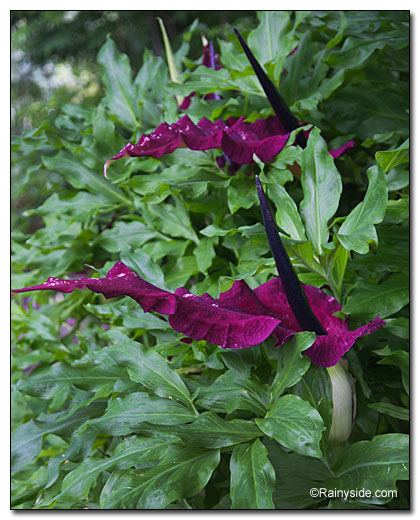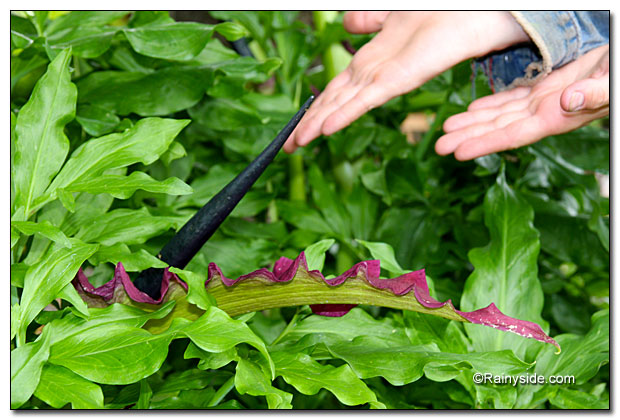Dracunculus vulgaris
VOODOO LILY, DRAGON ARUM, PURPLE DRAGON LILY, SNAKE LILY, BLACK ARUM, BLACK DRAGON, DRAGONWORT, STINK LILY
Family: Araceae
Pronounced: drak-UN-koo-lus vul-GAIR-iss
Quick Jumps
Growing Guide
Rainy Side Notes
GROWING GUIDE

Origin:
Central and East Mediterranean.
Plant Group:
Bulbs.
Hardiness:
Sunset zones: Not listed.
USDA zones: 5-10
Heat zones: 10-8
Mature size:
Height: 3-5 feet (1-1.5 m). (
Width: 24 inches (60 cm).
Flowering period:
Late spring to midsummer.
Flowering attributes:
The flowers—consisting of a spathe, maroon-purple hued on top and dull green underneath, 12-24 inches long and 6 inches wide, which surrounds a deep red to almost black spadix—release a foul-smelling odor to attract pollinators. Following the flowers, scarlet berries appear in late summer.
Leaf attributes:
Purple spotted stalks are topped with leaves comprised of 7-19 (sometimes more) white-streaked or purple mottled, mid-green leaflets.
Growth habit:
Upright.
Light:
Full sun to part shade.
Soil:
Humus rich, moist, well-drained soil.
Feeding:
Side dress with compost or leaf mold.
Propagation Methods:
In early spring, cut tubers in sections, including a bud in each section.
In autumn or early spring, separate tuber offsets.
Sow seed as soon as ripe.
Pruning Methods:
N/A
Pests and Diseases:
N/A
Rainy Side Notes

This wonderful plant appears to have enough common names to fill a ten-inch pot. I had to laugh when I came across Plant Delights Nursery's listing of a common name made in true Tony Avent fashion—Viagra lily.
If you do not know what pollinates this plant, just take a deep breath of the surrounding air when it comes into bloom. Once that smell hits your olfactory nerve, you will have no doubt what the voodoo lily is trying to lure. The odor is repulsive to us, but dung-loving flies and beetles adore the smell of carrion. It is best to site the plants away from windows and doors, as the smell is not something that inspires you to write poetry, the exception being if you were Edgar Allen Poe. Fortunately, the flower puts the odor into the air for only a few days, to gather in the pollinators. For the rest of its growing season, it adorns the garden with wonderful tropical-like foliage, large, unusual flowers, followed by Poe-approved, poisonous, scarlet berries.
Dracunculus vulgaris is a stress-free tuber to grow in the Pacific Northwest, providing you pay attention to its needs. The biggest problem we face, west of the Cascade Mountains, is its tubers rotting when not grown in well-drained soil. Stop watering it when the leaves dry up and go into dormancy. Supply it with compost or leaf mold to keep the soil humus rich, and you will have healthy plants that will grow tall and flower, coming back every year to throw its stench about for a few days.
Dracunculus has been used to fight cancer. Applied to cancerous growth, it is believed that its corrosive properties are what work against the growths.
All above ground parts and berries of Dracunculus are poisonous.
Photographed at Joy Creek Nursery.

Gardening for the Homebrewer: Grow and Process Plants for Making Beer, Wine, Gruit, Cider, Perry, and More
By co-authors Debbie Teashon (Rainy Side Gardeners) and Wendy Tweton
Copyright Notice | Home | Search | Bulbs

